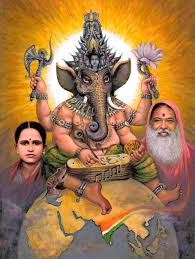Hare Srikrishna
Akrūra, who experienced horripilation seeing the Supreme Lord, continued to pray,
“Namo bhṛguṇāḿ pataye dṛpta-kṣatra-vana-cchide
namas te raghu-varyāya rāvaṇānta-karāya ca
O Lord, You are Bhargava-rama (Paraśurama) who travelled around the globe destroying hordes of arrogant, wicked kings. You are Raghurama, who reduced the mighty demon Ravana to dust. To You O Lord, I offer many obeisances.
Namas te vāsudevāya namaḥ sańkarṣaṇāya ca
pradyumnāyaniruddhāya sātvatāḿ pataye namaḥ
I offer obeisance to You, the saviour of the Yadavas. I offer obeisance to Balarama, Pradyumna and Aniruddha. I offer obeisance to the four concentric circles (vyuha) that go by the name Vāsudeva, Sankarṣana, Pradyumna and Aniruddha. O Lord, it is You who manifests in all these forms.
I offer obeisance to You, who resides in all the planes, who is an embodiment of illumination, who, being an embodiment of love attracts devotees towards Himself, who is supreme effulgence and who is ever independent”.
Who is Paramatma? Paramatma is He who, through the medium of love attracts devotees towards Himself. It is He who had enveloped the entire creation. It is He who is invisible. It is He who resides in the temple known as my heart. It is He who exists as my heart.
Elders often state that ‘namas te vāsudevāya’ itself is a very significant mantra. It should be chanted endlessly. Consider this as an upadesha (initiation) and chant it.
Namo buddhāya śuddhāya daitya-dānava-mohine
mleccha-prāya-kṣatra-hantre namas te kalki-rūpiṇe
You are Buddha, the embodiment of goodness, who preached non-violence and who deluded demons such as daityas and danavas. In future, You will incarnate as Kalki and will destroy wicked kings who are almost at the level of degraded mlecchas (those who have fallen from righteous conduct and purity). To You, O Lord, I offer obeisance”.
Although Bhagavatam agrees to the incarnation as Buddha, we should remember that it was not Gautama Buddha that is referred here. There is another Buddha-avatara explained in Bhagavatam, which is the real incarnation. Gautama Buddha followed the methods of the original Buddha. He is also a great personality, but he is different from the one mentioned in Bhagavatam.
The Lord incarnated as Buddha in that eon when the might of the demons was intolerable. These demons adhered to Vedic path and yet were violent in nature. On one hand they diligently abided by Vedic rituals, while on the other they would gobble or severely torture virtuous persons. To eradicate them, it was essential to put them in a non-Vedic path. It is adherence to Vedic path that gave them enormous energy. It was Yagna and Yaga that provided them with might. It was continuous penance and abidance to Vedic duties that gave them the strength using which they harmed the innocent.
So the Lord decided to trick them away from Vedic path so that their power diminished. With this motto, He incarnated as Buddha and, through various techniques, convinced them to abandon all Vedic rituals, from which stemmed their might. ‘Vedas do not have any proper background. They are false. There is nothing you will gain from them. Discard them totally’. Convinced by His arguments, they stopped their Vedic practices. Consequently, their strength significantly diminished.
This trick was designed to deviate the wrong-doers from the righteous path but in no way was it designed to stop the righteous persons from continuing their practices. We must never abandon Vedic rituals that fill us with positivity and strength.
We salute demons who tread the righteous path in all sincerity. But then, they should abstain from harming the pious, virtuous and saintly people. When this is followed, even demons are venerable.
Gautama Buddha followed the path of non-violence in order to reach the Lord. But what do we do? Do we abide by all his teachings? The most important preaching of Gautama Buddha was non-violence and non-injury to any animal. If so, it is right to consume fish and animals and then try to meditate upon the Lord? Gautama Buddha was a great person who trod the path of the Lord.
Both, Buddhas i.e. He who was an incarnation of Lord Maha-vishnu as well as Gautama Buddha preached non-violence. Gautama Buddha followed the preachings of Buddha, the incarnation. However, he never preached that Vedic rituals should be abandoned. In course of time, his followers added this as part of his teachings and propagated it. Gautama Buddha was a great saint. Commentators at times modify the original text. However, as Gautama Buddha was a noble saint who also preached the path of non-violence, there is no harm whatsoever in addressing him as an incarnation of the Supreme. All Mahatmas are filled with Godliness. They are focussed entirely upon the Lord. Gautama Buddha helped many to walk on the path of God.
We, who call ourselves as His followers, should abstain from harming others. But are we following his advice perfectly? We are killing and torturing animals. Is it right? However, a sea difference exists between the philosophy preached by Gautama Buddha’s followers and the true Vedantic philosophy. We should realize this.
Krishna Nārayana
